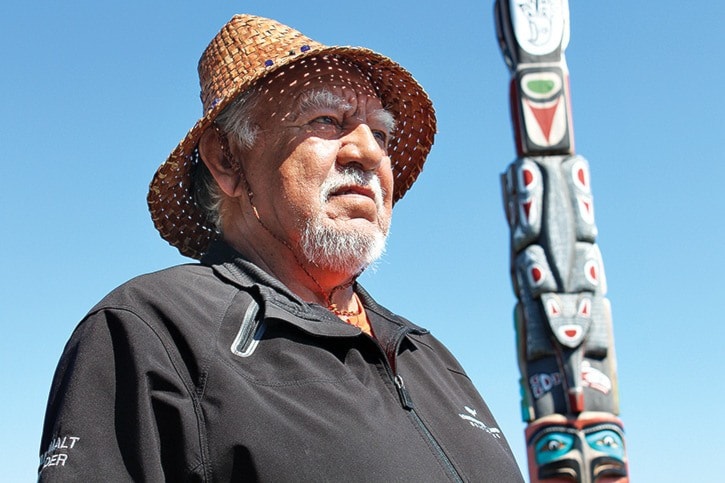The confines of insularity – Eunice Joe remembers them well.
She also remembers being a young mother with a desire to help herself and her community, and her struggle to conjure the courage to step past her fear of what was beyond the boundaries of her small world.
Joe recalls these things through the lens of more than a decade, from her comfortable seat as Vancouver Island manager for the First Nations Health Authority.
Her journey from the Tseshaht reservation outside Port Alberni to responsibility for meeting the health and wellness needs for not only her band, but also 50 Vancouver Island First Nations, is one most people would be proud of accomplishing.
It’s also one that she readily acknowledges would not have happened without Vancouver Island University.
It’s not a long journey over the hump from Alberni to Nanaimo, but for a younger Joe, it was a road to a different universe. Without VIU’s aboriginal support services and welcoming environment, she says loneliness and culture shock may have prevented her from obtaining her degree.
“That program was very supportive. It was my first time being that far from home,” she said. “Having an elder present helped me. Having that cultural piece was very comforting to me. Having an elder there – I don’t think I would have made it without them. It helped me get through.”
It wasn’t by accident that VIU worked for Joe, or is working for the more than 2,000 full- and part-time indigenous students – nearly one-fifth of the student body – currently attending the institution.
Under the guidance of president Ralph Nilson, the school has deliberately reached out to each of Vancouver Island’s three indigenous ethnic groups – the Coast Salish of the southeast, the Kwakwaka’wakw of the northeast and the Nuu-Chah-Nulth of the west coast. The university basically said: ‘You have so much knowledge about history, geography, language, the environment and so much more, we would be so grateful if you could share.’ The gesture of respect opened doors.
“We are saying ‘we can learn from you.’ It is a reciprocal arrangement,” Nilson said. “Truth and respect can only happen if we spend time together.”
The most prominent manifestation is the recognition of nine First Nations elders as faculty members at both the Nanaimo and Cowichan campuses. They help teach and guide courses and provide knowledge, support and perspective – not only to young aboriginal students, but also to all students and teachers.
Gary Manson of the Snuneymuxw has been a VIU elder-in-residence for the past few years. He appreciates what Nilson is trying to accomplish and sees his role as providing perspective on culture and history to the curriculum, comfort to students and guidance to the teaching staff.
“Young people are starting to embrace our culture but the residential schools have done their job,” he said. “I tell [today’s teachers] you are in a position to encourage an aboriginal person to succeed.”
Morgan Mowatt said the presence of the elders makes a real difference.
Mowatt, who is taking political science and aboriginal studies courses at VIU, is of Gitxsan and Scandinavian background. She grew up in Lantzville. She said for herself, the elders have helped forge a connection to her aboriginal heritage. For some of her classmates, the elders have given them a reason to think that university is a place where they belong.
”It’s useful to validate indigenous knowledge. People from remote communities see that,” she said. “People can go back to their communities and feel validated.”
Mowatt volunteers as a ‘Community Cousin,’ a student mentor working to help aboriginal students feel comfortable on campus. The university also has a large aboriginal student services department to support a healthy school-life balance. And then there is Shq’apthut – A Gathering Place, the First Nations student centre where this all comes together.
VIU offers full-ride scholarships to the top two students in each of the Island’s three aboriginal language groups. It is also the first university out of the gate to provide tuition to anyone coming out of foster care. Nilson said this is particularly relevant because even though First Nations people comprise four per cent B.C.’s population, they also comprise 64 per cent of the people in care.
“It’s clear evidence of the impact of the residential schools,” he said.
Joe, also an elected Tseshaht band councillor, watches former university classmates returning to their communities as teachers or political leaders, and inspiring their children. She sees the network of personal connections created at the university feeding a network up and down the Island, leading to new strength built on co-operation and numbers.
Manson is confident the work being done at the university, which builds on the themes of truth and reconciliation, is making a difference.
“There’s a lot of work to do. One hundred years of suppression is not going to disappear overnight. There’s anger on the aboriginal side and guilt on the other side,” he said. “We can’t be angry forever. Nobody is going away.”
